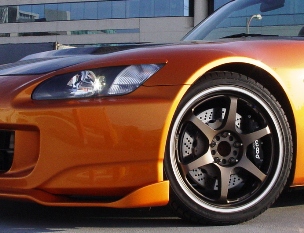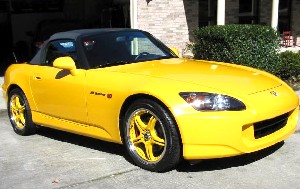Wheels and Tires: What are my choices?
If you’re like the typical S2000 owner, tires need to be replaced with sometimes great regularity. At some point, many of you will consider switching. Some of you simply want to change to a different tire to save money over the expensive OEM choices, while others will spend thousands on some bling bling Volks or other high-end aftermarket wheels.
 Wheels and tires can make a bold statement, or simply be a reflection of frugality. Some prefer lots of chrome, gold, or other bright look, while others prefer the stealthy approach of gunmetal and/or black. Some folks want the most grip possible in a tire and opt for a treadwear rating near 100, while others would rather have something that lasts for 50-60k miles and go for the treadwear ratings above 400. Wheels and tires are an easy way to customize the look and, to a lesser extent, the handling of your S2000 to your personal tastes. The options are limitless, and we’ll only scratch the surface here.
Wheels and tires can make a bold statement, or simply be a reflection of frugality. Some prefer lots of chrome, gold, or other bright look, while others prefer the stealthy approach of gunmetal and/or black. Some folks want the most grip possible in a tire and opt for a treadwear rating near 100, while others would rather have something that lasts for 50-60k miles and go for the treadwear ratings above 400. Wheels and tires are an easy way to customize the look and, to a lesser extent, the handling of your S2000 to your personal tastes. The options are limitless, and we’ll only scratch the surface here.
That said, what are the practical issues you should be thinking about before you make such a change???
Tires:
16” This is one of many places where Honda got it right the first time. The OEM tire choices for the S2000 have been excellent. The S2000 specific S02, offered on the ’00-’03 models, has exceptional grip for a street tire. In fact, we’ve yet to drive any other unshaved street tire that performs as well. That said, the S02 has two major drawbacks: first, they are not particularly effective tires in wet or rainy conditions. They don’t channel water terribly well, and don’t grip particularly well when wet. The other problem with the S02 is that being such a soft-grippy tire, they don’t last very long. A set of rears rarely last longer than 12-15k miles of spirited driving, although the fronts will usually make it for at least 20k. Being a limited production tire, they also tend to be quite expensive. An important note, should you decide to replace your OEM tires with something different: although the rear tire specified is a 225 width, it should be replaced with a 245 width tire if using anything other than the OEM S02 (The OEM S2000 S02 is designated by a “w.” and is the only S02 you should use on an S2000. The other is made for the Porsche Boxter.)
 An acceptable alternative to the S02 for those in wet climates is the Bridgestone S03. While this tire doesn’t have the grip of the S02, it performs much better in the water. If you’ve got the cash… these are your best alternatives. For those looking for lower cost replacement tires, many have turned to the offerings from Kumho and Toyo. The Kumho MX and the Toyo T1s offer acceptable performance at a much better price than the S02. Unfortunately, you get what you pay for, and these tires just don’t perform as well. The upside of this is that due to their harder rubber compounds, these tires tend to last much longer than OEM. Some folks have gone to the Yokohama ES100, but the savings aren’t as great as the Kumhos/Toyos, and the performance is no better. Many owners have also been happy with the Sumitomo HTRZ (not the more expensive HTRZ2) While this tire can be a bit noisy, it has excellent grip, decent wet capability, and is dirt cheap! This tire can also be shaved for the track, and when shaved to 4/32ds provides exceptional grip for a street tire.
An acceptable alternative to the S02 for those in wet climates is the Bridgestone S03. While this tire doesn’t have the grip of the S02, it performs much better in the water. If you’ve got the cash… these are your best alternatives. For those looking for lower cost replacement tires, many have turned to the offerings from Kumho and Toyo. The Kumho MX and the Toyo T1s offer acceptable performance at a much better price than the S02. Unfortunately, you get what you pay for, and these tires just don’t perform as well. The upside of this is that due to their harder rubber compounds, these tires tend to last much longer than OEM. Some folks have gone to the Yokohama ES100, but the savings aren’t as great as the Kumhos/Toyos, and the performance is no better. Many owners have also been happy with the Sumitomo HTRZ (not the more expensive HTRZ2) While this tire can be a bit noisy, it has excellent grip, decent wet capability, and is dirt cheap! This tire can also be shaved for the track, and when shaved to 4/32ds provides exceptional grip for a street tire.
17” With the advent of 17” wheels on the S2000, Honda went away from the S02 to a new tire, the RE050. In many ways, this tire is a “best of both worlds” alternative. The tire is nearly as grippy as an S02, but with the excellent wet capabilities of the S03. Again… if you can afford it, these are you best replacement option in the 17” size. (too bad they don’t make ‘em in 16s) Again, there are acceptable lower cost alternatives from Kumho, Toyo, and Sumitomo. When replacing your OEM 17s with an aftermarket tire, it’s important to note that the 215 RE050 is only 6.7”, significantly narrower than most other 215/45/17s. Depending on your tire choice, you may want to consider a 205 instead if you want the exact same feel of OEM.

R-compounds: For serious tracking/auto-x the grip of street tires is very limiting. Many drivers choose to switch to a race-compound tire for the extra hold. R-compound tires offer as much as a 40% increase in grip over even the best street tires, and can make a huge difference in lap/run times. There are a number of options available in racing compound tires, but two seem to be the favorites with the S2000 crowd. The Toyo RA-1 is a terrific tire. Priced a bit less than S02s, the RA-1 is a wonderfully grippy option for our car. They offer either a 205 or 225 front option in the 16” size (245 rear), and when shaved to 4/32nds they stick like glue! The Nitto Nt01 offers similar grip at a slightly lower price. The Nitto also comes with a standard 6/32ds of tread as opposed to the 8/32ds on an RA-1, so they don’t need to be shaved when new and therefore last a bit longer. The Kumho V700 is a lower cost, but not quite as good option, and the V710 offers exceptional grip, but very short life. The r-comps from Hoosier offer probably the berst grip of all, but they’re quite expensive, can’t be driven on the street, and wear out very quickly.
There are a myriad of other tire options not discussed here that may also be fine choices. Please visit the discussion thread attached immediately below to read what others have to say or post up your own tire reviews, good and bad.
https://www.s2ki.com/forums/index.php?showtopic=403274
Wheels:
This is not a review of specific wheel brands/models, but rather an overall look at the options available. There are a tremendous number of aftermarket wheel alternatives for the S2000. The price range can vary drastically from complete sets starting under $1k to expensive, custom made, three piece options that can cost upwards of $4k. Besides price range, the first thing you’ll need to determine is the size of the wheel you want. Pre ’04 S2000s come from the factory with 16” wheels while the ’04 models and beyond come equipped with 17s. The bigger the wheel, the more it tends to fill the gap in the wheel well which is a look most owners prefer. Unfortunately, the bigger the wheel, the heavier each gets. Heavier wheels require more energy to spin them and therefore will tend to be less efficient in transferring your horsepower to the street. That’s the disadvantage of bigger wheels. The advantage, other than looks, is that you can run bigger/wider tires. More tire means more grip, but it also means more friction/resistance and therefore less speed. For track applications, most of the S2000 racers have decided that the 17” wheel is the happy medium between weight and size. There are several good options in the 15-17lb range. For street applications, the 18” wheel seems to be the preferred look. There are way too many brands/models to discuss here, so we won’t even begin to try. Be sure to visit the wheel and tire forum for the latest available options, tons of photos, volumes of information, and some great sponsors.
https://www.s2ki.com/forums/index.php?showforum=56
Wheel stagger: Unlike many cars, the S2000 comes from the factory with different size wheels and tires front and back. It’s a good idea to maintain a similar stagger f-r when going with an aftermarket setup unless you plan to make other changes as well. A number of S2000 owners have recently gone away from the staggered setup in order to run rear-width tires in front. While this will definitely add more grip, it’s important to balance the setup by either adding a stiffer front sway bar, or disconnecting/removing the rear. If you run a non-staggered tire setup without changing the sway bar setup, you’ll find that the car has a much greater tendency towards over steer, and the rear will slide out much too easily.
Offsets: Most of you have heard this term, but not everyone knows what it means. Any wheel you might want to use not only has to have the correct 114mm x 5 bolt pattern, the correct offset on aftermarket wheels is also imperative. A wheel offset is the measurement that determines how far the wheel will protrude from the hub. Too much offset and the inner clearance won’t be sufficient to avoid contact with the suspension parts. Too little offset and the wheel will protrude beyond the fender. Either too much or too little offset can cause tire rubbing. Here’s a great thread to see if those wheels you want will fit or not:
https://www.s2ki.com/forums/index.php?showtopic=342793
Fender rolling: Here’s another term many of you have heard but may not all be completely familiar with. There is a lip on the inside of the wheel wells in the rear fenders that larger wheel/tire combos may rub against. Fender rolling is the process of bending that lip up and out of the way to allow more room in the well.
Powdercoat/chroming: For those looking for a different look, but not wanting to drop a lot of money on aftermarket wheels, chroming/powdercoating is an option. Powdercoating is a process by which color is fused to your OEM wheel in much the same way wheels are chromed. Both provide a durable/long lasting surface much superior to paint.
Bargains can also often be found on new wheels in our Group Buy Forum,
https://www.s2ki.com/forums/index.php?showforum=5
and great prices on used wheels can be found in the S2ki For Sale forum
https://www.s2ki.com/forums/index.php?showforum=107
as well as your local regional forums.
